Struggling to choose between e-coating and anodizing for your metal finishing? Feeling lost in the technical jargon? You’re not alone.
E-coating and anodizing both offer protection, but cater to different needs. Anodizing excels in harsh environments, while e-coating provides a uniform, decorative finish.
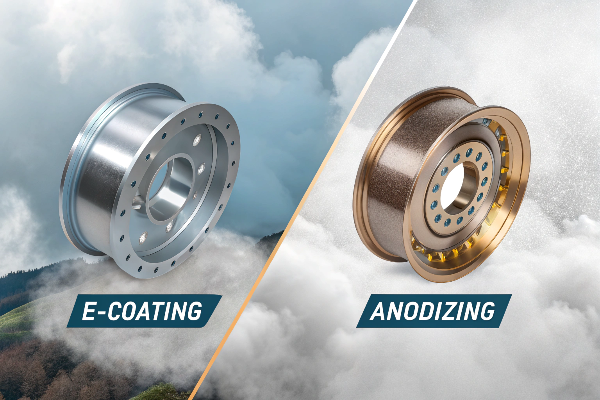
But that’s just scratching the surface. Let’s dive deeper into each process to help you make the best decision for your project. I will tell you everything from my working experience.
How Long Does E-coating Last?
Worried about your e-coating fading or peeling after a short time? Don’t want to re-coat every few years? This is a normal problem.
With proper pre-treatment and application, an e-coat finish can last 10-20 years1, or even longer, depending on environmental conditions and wear.
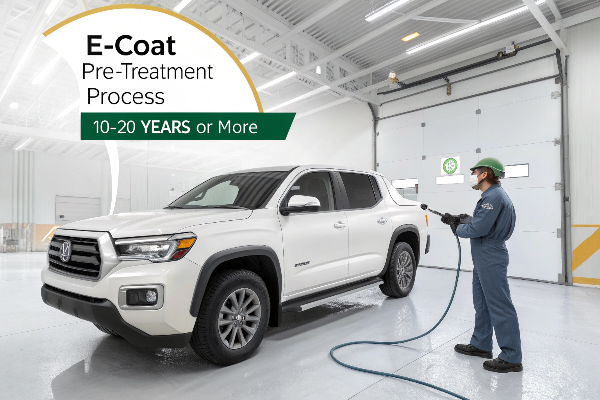
Factors Influencing E-coating Lifespan2
The lifespan of e-coating isn’t a fixed number. It’s a complex interplay of various factors. Let’s examine them for my past work experience:
| Factor | Impact on Lifespan | Example,in my factory |
|---|---|---|
| Pre-treatment | Proper cleaning and preparation are CRUCIAL. | A poorly cleaned surface will lead to premature coating failure. I always make sure that. |
| Coating Thickness | Thicker coatings generally provide longer-lasting protection. | Our standard range is 20-30 microns. |
| Environmental Factors | Consider, consider. | The hot weather or rains. |
| UV Exposure | Will cause some coatings to degrade over time. | For outdoors, I always tell clients to add a UV-resistant topcoat3. |
| Wear and Tear | Physical abrasion, scratch the coating. | We did some tests to evaluate it. |
| Chemical Exposure | Harsh chemicals can damage or dissolve the coating. | I need to ask clients the chemical composition. |
My client, Victor, from Canada, once asked me about the use of titanium anodes in extremely cold climates. He has question in lifespan, I told him the above.
Is E-coating UV Resistant?
Concerned about your coated parts fading or chalking under the sun? Wondering if e-coating can withstand prolonged UV exposure? Common questions for clients.
Standard e-coating offers limited UV resistance4. For significant UV protection, a UV-resistant topcoat is usually required.
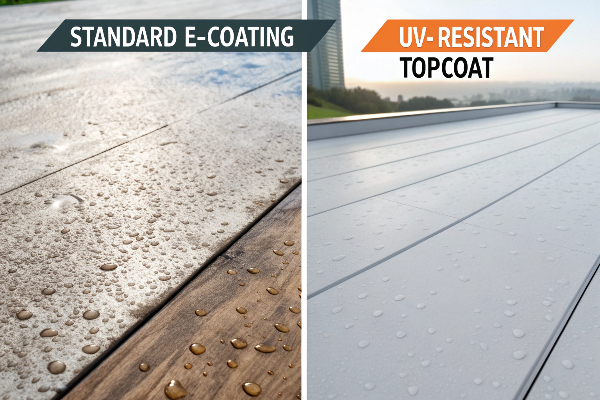
Understanding UV Degradation5 and Protection
UV radiation from sunlight can wreak havoc on many materials, including coatings. Here’s a breakdown of why and how to address it:
| Aspect | Explanation | My experience |
|---|---|---|
| UV Degradation | UV light breaks down the chemical bonds in the coating, leading to fading, chalking (a powdery surface), and loss of gloss. | I’ve seen this happen with some cheaper e-coat formulations. |
| Standard E-coating | Most e-coat formulations (especially epoxy-based) have inherent LIMITED UV resistance. They will degrade over time with prolonged sun exposure. | Fine for indoor applications, but problematic outdoors. |
| UV-Resistant Additives | Some e-coat formulations include UV absorbers or stabilizers. These help, but may not be sufficient for long-term outdoor use in high-UV environments. | We offer this as an option, but it adds to the cost. |
| UV-Resistant Topcoats | The BEST solution for long-term UV protection is to apply a clear, UV-resistant topcoat (often polyurethane-based) over the e-coat. | This is what I ALWAYS recommend for outdoor applications, especially in Australia. |
What is the Difference Between Anodizing and PVD Coating?
Confused by the terms "anodizing" and "PVD coating6"? Trying to figure out which one is right for your project? These are very two different things.
Anodizing is an electrochemical process that grows an oxide layer on a metal (usually aluminum), while PVD coating is a vacuum deposition process that applies a thin film of material.
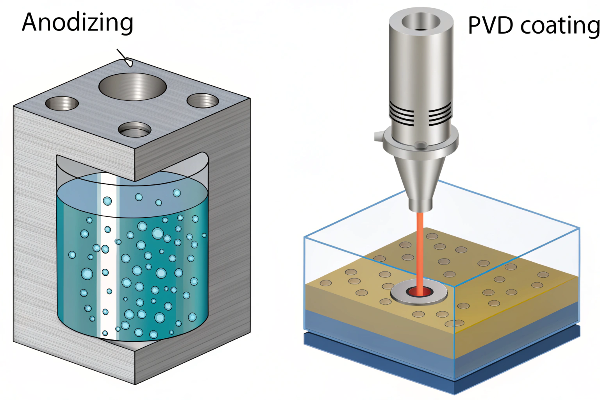
A Deep Dive into Anodizing and PVD Coating
These two processes, while both used for surface finishing, are fundamentally different in their approach and the resulting properties.
| Feature | Anodizing | PVD Coating | Xuboti’s Experience |
|---|---|---|---|
| Process | Electrochemical conversion of the metal surface into an oxide layer. | Physical vapor deposition: material is vaporized and deposited on the substrate in a vacuum. | We specialize in anodizing titanium, providing a durable, corrosion-resistant oxide layer. |
| Materials | Primarily for aluminum, but also titanium, magnesium, and zinc. | Wide range of materials: metals, ceramics, and even some polymers. | Titanium anodizing is our core expertise. |
| Layer Type | Integral oxide layer – part of the base metal. | Deposited thin film – a separate layer on top of the substrate. | Anodized layers are incredibly adherent. |
| Thickness | Typically a few micrometers to tens of micrometers. | Typically a few nanometers to a few micrometers. | We control anodizing thickness precisely based on client needs. |
| Hardness | Harder than the base metal, but can be brittle. | Can be extremely hard (depending on the coating material). | Anodized titanium is surprisingly hard, but PVD can offer even greater hardness. |
| Color | Naturally silver-gray, but can be dyed in a range of colors. | Wide range of colors and finishes, including metallic, ceramic, and even decorative patterns. | We offer a variety of colors for anodized titanium. |
| Corrosion Resistance | Excellent corrosion resistance, especially for aluminum. | Excellent corrosion resistance, depending on the coating material. | Anodizing provides exceptional corrosion protection in many environments. |
| Applications | Architectural components, aerospace parts, consumer electronics, cookware. | Cutting tools, medical implants, automotive parts, decorative coatings. | Our anodized titanium is used in electrochemical applications, water treatment, and more. |
What is E-coating?
Heard the term "e-coating" but not sure what it really means? Want a simple explanation of this finishing process? Let’s break it down.
E-coating, or electrophoretic deposition, is a painting process where charged paint particles are attracted to an oppositely charged metal part, creating a uniform, durable coating.
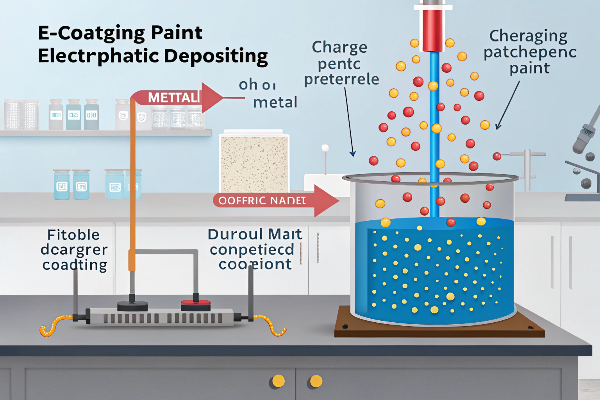
E-coating Explained: Process, Benefits, and Limitations
E-coating is like a highly controlled, electrically charged bath for metal parts. Here’s a more detailed look:
| Aspect | Description | My comments |
|---|---|---|
| The Process | 1. Parts are cleaned and pre-treated. 2. Submerged in a bath containing electrically charged paint particles. 3. A DC current is applied. | The pre-treatment is critical for good adhesion. |
| Types of E-coating | Cathodic: Part is the cathode (negatively charged). Most common. Anodic: Part is the anode (positively charged). Less common. | Cathodic epoxy is the most widely used type in my experience. |
| Paint Types | Epoxy, Acrylic, and Polyurethane. | Each type has its own advantages and disadvantages. |
| Benefits | Uniform coating thickness, even on complex shapes. Excellent corrosion protection7. Can be used as a primer or a topcoat. | The uniform coverage is a major advantage over spray painting. |
| Limitations | Limited color options compared to other painting methods. Requires specialized equipment. Not suitable for all materials. | It’s not a one-size-fits-all solution. |
| Applications | Automotive parts, appliances, metal furniture, and electrical components. | I’ve seen it used extensively in the automotive industry. |
Does Low-E Coating Wear Off?
Concerned about the longevity of low-E coatings on your windows? Wondering if they’ll lose their energy-saving properties over time? It is important.
Modern low-E coatings are very durable and are designed to last the lifetime of the window, typically 20 years or more. However, improper cleaning can damage them.
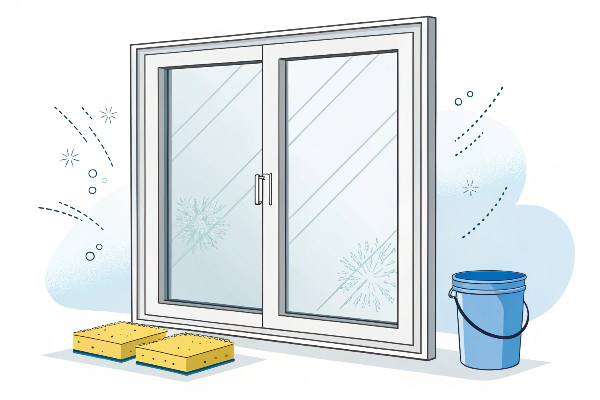
Understanding Low-E Coating Durability and Maintenance
Low-E (low-emissivity) coatings are incredibly thin layers of metal (usually silver) applied to window glass to improve energy efficiency.
| Aspect | Explanation | My comments |
|---|---|---|
| Types of Low-E | Hard-coat (pyrolytic): Applied during glass manufacturing. More durable. Soft-coat (sputtered): Applied after. Better performance. | Soft-coat is more common now due to its superior performance. |
| Durability | Both types are designed to be very durable. Hard-coat is inherently more resistant to scratches. | I always emphasize proper cleaning to clients. |
| Lifespan | Should last the life of the window (20+ years) if properly maintained. | I’ve seen low-E coatings last much longer than that with good care. |
| Cleaning | Use mild soap and water. AVOID abrasive cleaners, harsh chemicals, and sharp tools. | Abrasive cleaners are the biggest enemy of low-E coatings. |
| Damage | Scratches or chemical damage can compromise the coating’s performance. | Damage is usually localized and doesn’t "spread" across the entire coating. |
| Location of Coating | The coating is usually applied to an interior surface of the insulated glass unit (IGU), protecting it from direct contact. | This protects it from most wear and tear. |
Does E-coating Prevent Rust?
Worried about your metal parts corroding? Thinking about using e-coating for rust protection? That’s the key point for some products.
Yes, e-coating provides excellent rust prevention by creating a barrier between the metal and the environment, especially when combined with proper pre-treatment.
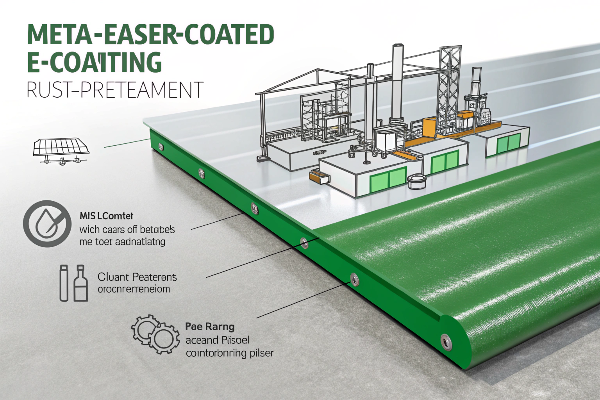
E-coating’s Rust Prevention Mechanism: A Deeper Look
Rust is an electrochemical process (oxidation) that occurs when iron or steel is exposed to oxygen and moisture. E-coating combats this in several ways:
| Aspect | Explanation | My factory’s experience |
|---|---|---|
| Barrier Protection | The e-coat layer acts as a physical barrier, preventing oxygen and moisture from reaching the metal surface. | This is the primary mechanism of rust prevention. |
| Adhesion | A properly applied e-coat adheres tightly to the metal, preventing gaps where corrosion could start. | We use phosphate pre-treatment to enhance adhesion, especially for steel. |
| Uniform Coverage | E-coating provides complete and even coverage, even in hard-to-reach areas, eliminating weak spots where rust could form. | This is a major advantage over traditional painting methods. |
| Chemical Resistance | Many e-coat formulations are resistant to chemicals that can accelerate corrosion. | We can tailor the e-coat formulation to the specific environment the part will be used in. |
| Pre-treatment | Proper pre-treatment, such as phosphating, creates a conversion coating that further enhances corrosion resistance. | This is ABSOLUTELY ESSENTIAL for long-term rust prevention. I always follow the strictly process. |
| Types of Metal | E-coating is effective on various metals, including steel, aluminum, and zinc. | We regularly e-coat both steel and aluminum parts for rust protection. |
| Limitations | While e-coating is excellent, it’s not a perfect solution. Deep scratches that penetrate the coating can expose the metal and lead to rust. | I always advise clients to handle e-coated parts with care to avoid damage. I choose strong packing box for long time transportation. |
Conclusion
Choosing between e-coating and anodizing depends on your specific needs. Anodizing for tough environments, e-coating for uniform finish, and understanding their nuances, like UV resistance and lifespan, is key.
-
Understanding the longevity of e-coat finishes can help you make informed decisions about maintenance and durability. ↩
-
Exploring these factors can provide insights into how to maximize the lifespan of your e-coating, ensuring better performance. ↩
-
Learning about UV-resistant topcoats can help you protect your e-coating from degradation and extend its life. ↩
-
Understanding UV resistance is crucial for selecting the right coating for outdoor applications. Explore this link for detailed insights. ↩
-
Learn about the impact of UV degradation on coatings to make informed decisions for your projects. This resource provides valuable information. ↩
-
Discover the PVD coating process, its advantages, and how it differs from other coating methods for better project decisions. ↩
-
Explore how e-coating offers superior corrosion protection, essential for metal longevity. ↩





